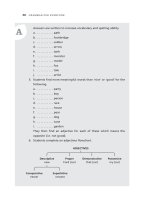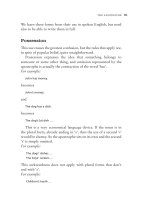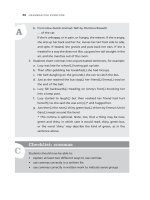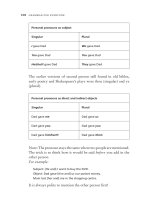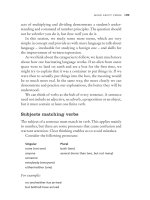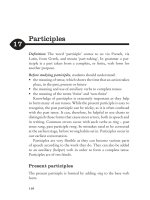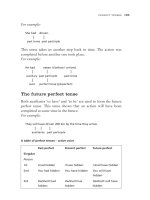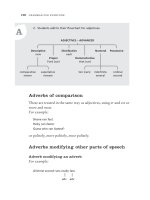Tài liệu Grammar for everyone part 27 docx
Bạn đang xem bản rút gọn của tài liệu. Xem và tải ngay bản đầy đủ của tài liệu tại đây (104.04 KB, 7 trang )
172
G r A M M A r f o r e V e rY o n e
Adverbial clause of purpose, modifying the verb ‘is working’ in
the main clause
Complex sentence
Adverbial clause of concession
This clause tells you that something happened in spite of another
occurrence.
Although I like insects I do not wish to study entomology.
in spite of the fact that
Finite verbs: like, do wish
Main clause: I do not wish to study entomology
Conjunction: although
Subordinate clause: I like insects
Adverbial clause of concession modifying the verb ‘do (not) wish’
in the main clause
Complex sentence
Adverbial clause of comparison
This clause describes how something compares with something
else.
That spider was more colourful than the others in the shed (were).
compared with
Finite verb: was, (were)
Main clause: That spider was more colourful
Subordinate clause: than the others in the shed (were)
A
Adverbial clause of comparison modifying the verb ‘was’ in the
main clause
Complex sentence
In adverbial clauses of comparison, the verb is often omitted,
as it is understood, so the above sentence makes sense even with
the omission of the word ‘were’. However, we show that it is
understood.
26.2 Activities: adverbial clauses
1. Students bracket the conjunctions and underline the adverbial
clauses in the sentences provided, and state what kind of clause
each is, for example:
We were fishing [where] the smugglers used to land.
Adverbial clause of place
a. We had to rush home as a storm was breaking.
b. We wanted to get back before it got dark.
c. We had caught a fish as big as the one Dad caught last Sunday.
d. My brother is only little, so I carried his bucket for him.
e. We cleaned the fish quickly so that we could grill it for dinner.
2. A simple sentence is written on the board, and students in turn add
an adverbial clause and state what kind they have used. One or two
may also be done in writing, for example:
Dad went shopping … because he needed new golf balls.
Adverbial clause of reason
a. Cathy laid the table.
b. Lock the door.
c. I caught the bus.
d. Luke was angry.
e. We had a lot of fun.
173
c l A u s e s
174
G r A M M A r f o r e V e rY o n e
C
Checklist: adverbial clauses
Students should now be able to:
• explain the difference between a phrase and a clause
• mark the adverbial clauses in sentences or a given passage
• add adverbial clauses to simple sentences
• name the kind of clause being used
• analyse a complex sentence containing an adverbial clause using a
structure and format
Noun clause
Noun clauses are not difficult to recognise once they are seen as a
unit performing the same function as a noun. As such, they form
the subject, object or complement of a verb.
It is clear from the following examples that a noun clause is
usually introduced by either a conjunction or a relative pronoun,
so as with the other kinds of clause, ask yourself what function it
is performing in the sentence.
For example:
• as the subject:
Where he hid the money is still a mystery.
• as the object of a verb:
They now know who the thief was.
• as the object of a preposition:
He will be punished for what he has done.
• as the complement:
This was how it was done.
A
26.3 Activities: clauses
(Identifying is a process of logical thinking.)
1. Students identify noun clauses in a passage, for example:
Three men were seen in the car park after dark. Who they were
(s) was impossible to tell. We wonder what they were up to (o).
That they were up to no good (s) was obvious, as they were
wearing dark clothing with balaclavas over their heads. We called
the police, but we didn’t know how long they would take
to get
here (o). We didn’t know what to do (o), so, shaking with fear,
we hid behind a car that was parked nearby. We were relieved
when they arrived. That is exactly what happened. (compl.)
2. Students list any other clauses they can find in the passage and state
what kind they are, for example:
a. as they were wearing dark clothing … [adverbial clause of
reason (modifying the verb ‘was’)]
b. so we hid behind a car …. [adverbial clause of result (modifying
the verb ‘know’)]
c. that was parked nearby … [adjectival clause (qualifying the
noun ‘car’)]
d. when they arrived …. [adverbial clause of time (modifying the
verb ‘were relieved’)]
3. Students select all, or a stated number, of phrases from the passage,
for example:
Adverbial: in the car park (place)
after dark (time)
over their heads (place)
behind a car (place)
Adjectival: with balaclavas … qualifying (clothing)
shaking with fear … qualifying (we)
parked nearby … qualifying (car)
Noun: what to do (object)
175
c l A u s e s
176
G r A M M A r f o r e V e rY o n e
A
C
4. Students write their own short story including clauses or phrases as
suggested. These should be identified. The clauses or phrases may
come in any order and additional ones other than those specified
may be included, for example:
a. two adverbial clauses and an adverbial phrase
b. one adjectival clause and one noun phrase
c. a noun clause and an adverbial clause
d. one noun clause, one adjectival clause and an adjectival phrase
e. one adjectival clause, one noun clause and one adverbial phrase
Checklist: clauses
Students should now be able to
• define the term ‘clause’
• differentiate between phrases and clauses
• identify clauses in written material and state the kind of each –
adverbial, adjectival, noun
• identify the function of specific noun clauses, i.e. subject, object,
complement
• add specific kinds of clause to simple sentences
• use clauses of all kinds correctly in their own composition
